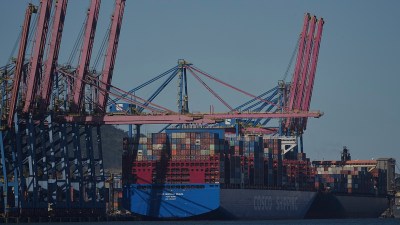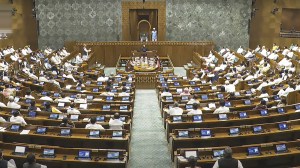Operation Sindoor stood out owing to political, military resolve and Indian forces’ precision strikes: Maj Gen Gaurav Bagga in Gandhinagar
After the Pahalgam terror attack, there was a huge amount of cyber attack, he recalled, saying: “They were all neutralised by our warriors.”
 “After the operation, the Prime Minister, however, said that Operation Sindoor was not over. He meant that every time there is a terror attack, there will be a response. And for that, we will choose the time, the place and the medium. But there will be a response. It will no more be the status quo. It will no longer be: ‘It happens’. We will not show patience. So any act of terrorism will be construed as an act of war,” Major General Bagga added.
“After the operation, the Prime Minister, however, said that Operation Sindoor was not over. He meant that every time there is a terror attack, there will be a response. And for that, we will choose the time, the place and the medium. But there will be a response. It will no more be the status quo. It will no longer be: ‘It happens’. We will not show patience. So any act of terrorism will be construed as an act of war,” Major General Bagga added.
Attributing the success of Operation Sindoor to a combined effort of political and military resolve and the ability of Indian Armed Forces to execute such precision strikes using the most indigenous technology, Major General Gaurav Bagga, General Officer Commanding (GOC), Golden Katar Division, on Thursday said that these make this operation different than the ones executed previously.
While speaking about the Operation Sindoor, a counter terrorism operation, at Karnavati University in Gandhinagar’s Uvarsad on Thursday, Major General Bagga said: “Unlike a conventional operation that would classically mean that the war is being announced and the army crosses the land, Air Force flies across the enemy territory and the Navy does what it does, there was a contact of forces on the ground, there was another stream of war that was very, very selective. You saw that after the Uri attack, there were surgical strikes, which were precise. This time, we wanted to hit the terrorist camps, which were troubling India.” This was the first time a GOC-rank officer came out in public to talk about the Operation Sindoor in Gujarat.
He also said the operation was planned in a manner “that we hit terrorism, no collateral damage — that means not a single civilian got hit”. “And the message was very clear that terrorism is what troubles us, terrorism is why Pahalgam happened, and we are going to get back at you. So that is how Operation Sindoor was different. And as Pakistan continued to strike relentlessly for two nights, we again went across the spectrum of the entire country right from north to south. Each air field of theirs was brought down, meaning that the Air Force was grounded. They couldn’t fly. And if we had taken it to the next stage, then they would have had to fight the war without their Air Force. No county can do that. That is how different was the political resolve, the military resolve, and the ability of India to execute such precision strikes, using most indigenous technology or technology that we had chosen in collaboration with our friendly countries,” he added.
“The Prime Minister (Narendra Modi) was absolutely clear about what he wanted, and had said: ‘We will hunt you down and we will do what we want to do.’ That was a stern warning. He was representing the emotion of the whole country. And that was a loud statement to make, and therefore, preparation for Operation Sindoor started. Preparations started at political level, which was of CCS (Cabinet Committee on Security), then there was military level, and there were global actions. Blackout drills were carried out in the country. Pakistan had a lot of long missiles. And therefore, the whole nation had to be ready,” he said.
Initially, he said, there were “21 targets set as we had decided to target terrorist camps as our fight, in principle, was against terrorism”, adding that nine of them were finalised after analysing all.
“It was being planned behind closed doors by the highest planners. Out of the nine targets, seven were hit by the Indian Army, and two by the Indian Air Force and the Navy.
After the Pahalgam terror attack, there was a huge amount of cyber attack, he recalled, saying: “They were all neutralised by our warriors.”
Further speaking on how Pakistan changed its strategy each time it failed,, Maj Gen Bagga said that it was the frustration of the nation that was evident in these changed tactics.
He went on: “102 terrorists were neutralised. And ultimately, Pakistan had to respond. After this attack, a call was made to the Pakistani DGMO that we had launched an operation, we had finished it and that we had to strike the terrorist camps — to which Pakistan obviously had to respond. We don’t have any terrorist camps so they started targeting military infrastructure in Srinagar, Baramulla, Jammu, Rajouri, Avantipora, Amritsar, Hoshiarpur, Gurdaspur. There were drones, missiles and artillery shelling, apart from unprovoked firing. Every drone which came in was neutralised. So whatever effort they put in could not meet any success. None of our components got hit or destroyed. None of our assets were damaged because of the superior countermeasures that we had instituted. The DGMO then changed tactics. Gurdwaras, madrasas were hit. By the next day, 300-400 drones had hit 36 locations from Leh to Sir Creek. Every artillery shell and civilian airlines they used as a shield failed and the frustration level was going up. Then there were Turkish drones, there were Chinese drones, and some of their indigenous drones. Each one was being neutralised. This was how their attacks were systematically destroyed.”
Terming the intervening night of May 9 and 10 as the one that goes in the history in terms of usage of assets in one night during any national operation, he said, “All the air bases of Pakistan, all airports, assets were destroyed by the Indian army. We were destroying them and showing proofs to people. Most of the airfields had been destroyed. So where does the aircraft take off from? In case the operation went further, it had to go to the next level where the army, Air Force and Navy got engaged. And when their airports started getting destroyed, they knew they had no ability to launch air operations against India in case the war went ahead. Immediately, our DGMO got a call and was told that they were ready for a ceasefire. Our DGMO said: ‘Let’s talk about ceasefire.’ And then we started the next phase of our operations.”
Among the challenges that India faced was also countering Pakistan’s propaganda of spreading misinformation. “They just, very subtly, put out that 20 Indian Army bases had been destroyed. They were all fake. During such operations, citizens are expected to look at only authentic sources (for misinformation),” he stated, also adding a word of caution: “If the source of a message is not authenticated, don’t push it forward.”.
“After the operation, the Prime Minister, however, said that Operation Sindoor was not over. He meant that every time there is a terror attack, there will be a response. And for that, we will choose the time, the place and the medium. But there will be a response. It will no more be the status quo. It will no longer be: ‘It happens’. We will not show patience. So any act of terrorism will be construed as an act of war,” Major General Bagga added.












